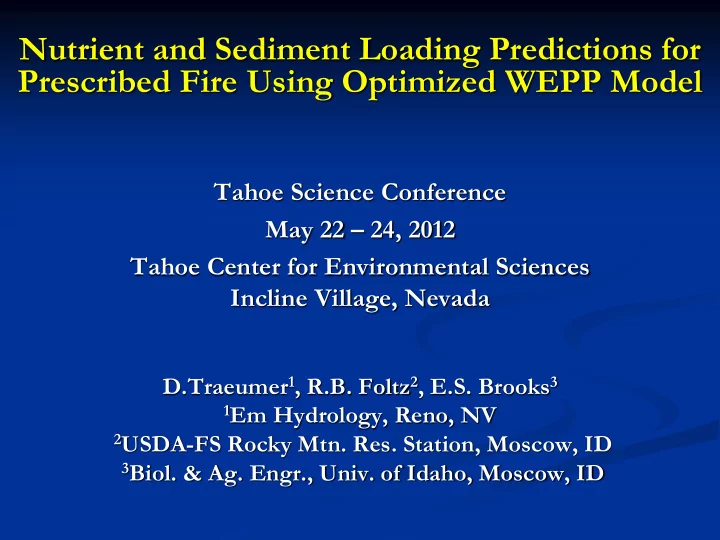

Nutrient and Sediment Loading Predictions for Prescribed Fire Using Optimized WEPP Model Tahoe Science Conference May 22 – 24, 2012 Tahoe Center for Environmental Sciences Incline Village, Nevada D.Traeumer 1 , R.B. Foltz 2 , E.S. Brooks 3 1 Em Hydrology, Reno, NV 2 USDA-FS Rocky Mtn. Res. Station, Moscow, ID 3 Biol. & Ag. Engr., Univ. of Idaho, Moscow, ID
Background and Problem Limited knowledge about impacts from pile burning on water quality Limited knowledge about impacts of spatial and temporal variability of soil hydrophobicity Filling these knowledge gaps has been identified as a priority research need And of course, the TMDL
Objectives Optimize WEPP’s most sensitive soil parameters Predict sediment and nutrient loads from burn piles Volcanics and granitics Spring and Fall (investigate seasonal hydrophobicity)
Why WEPP? Hillslope-scale Runoff, erosion, sediment yield, and particle size sorting predictions Average annual, return period, and event predictions Particle size sorting allows for VFS (<16um) calcs Runoff predictions allow for nutrient load calcs
Optimizing WEPP Rainfall simulations Hydraulic conductivity (infiltration rate) Interrill erodibility (overland flow and rain splash) Runoff and sediment nutrient quality* Soil Texture Rill runoff simulations Rill erodibility (concentrated flow) * Used to calculate nutrient loads
Rainfall and Rill Runoff Simulations 4 Sites 2 Volcanic 1 Mixed Colluvium 1 Mixed Glacial Outwash 2 Seasons Spring and Fall 2 Forest + 4 Burn Piles per site per season
Optimization Results Volcanic Colluvium Optimization Results Ki Kr K sat ortho-P Ads P Ammonia Nitrate (10 6 kg s m -4 ) (10 -3 s m -1 ) (mm hr -1 ) (mg L -1 ) (mg L -1 ) (mg L -1 ) (mg L -1 ) Fall 1.28 0.019 3.2 0.65 379 0.04 0.09 Forest Fall 2.55 0.291 12.4 1.04 37 2.79 1.58 Burn Spring 2.20 0.019 48.0 0.16 303 0.13 0.10 Forest Spring 1.70 0.291 29.0 0.35 513 0.81 0.32 Burn
Optimization Results Mixed Glacial Outwash Optimization Results Ki Kr K sat ortho-P Ads P Ammonia Nitrate (10 6 kg s m -4 ) (10 -3 s m -1 ) (mm hr -1 ) (mg L -1 ) (mg L -1 ) (mg L -1 ) (mg L -1 ) Fall 49.00 0.039 3.5 0.08 738 0.13 0.59 Forest Fall 3.50 1.985 13.8 0.36 110 0.25 0.24 Burn Spring 49.00 0.039 50.0 0.18 64 0.15 0.29 Forest Spring 3.50 1.985 32.0 0.35 85 0.25 0.25 Burn
Optimization Results Mixed Colluvium Optimization Results Ki Kr K sat ortho-P Ads P Ammonia Nitrate (10 6 kg s m -4 ) (10 -3 s m -1 ) (mm hr -1 ) (mg L -1 ) (mg L -1 ) (mg L -1 ) (mg L -1 ) Fall 0.65 0.036 3.5 1.03 112 0.04 0.33 Forest Fall 1.40 0.527 13.8 0.86 217 3.00 0.57 Burn Spring 0.65 0.036 50.0 0.30 837 0.24 0.45 Forest Spring 1.40 0.527 32.0 1.22 118 0.52 0.44 Burn
Ksat Results Fall volcanic forest < burned (75% less) with forest and burned soil saturations at 65% and 18%, respectively Volcanic forest and burned increased from fall to spring (1400% and 134%, respectively) Within first year, volcanic burned increased to ~ 60% of forest (spring values) Little difference between volcanic and mixed glacial outwash spring values: function of texture?
Modeling Methods and Assumptions Burn pile length 12 ft Spacing between piles 12 ft Forest length 12 ft Width 12 ft 50% cover (rock, ash, char ) Seasonal hydraulic conductivities held constant 100-yr climate : annual and summer /fall (Oct – Nov) No vegetation growth or senescence
Optimization Results Sediment Loads (lbs/yr) Summer/Fall Annual Slope (%) Forest Burn Pile Forest Burn Pile Volcanic 10 - 50 0 0.01 - 0.65 0 0 - 0.02 Colluvium Mixed 10 - 50 0 0 - 0.02 0 0 Colluvium Mixed Glacial 10 - 25 0 0 0 0 Outwash
Optimization Results Adsorbed P Loads (mg/yr) Summer/Fall Annual Slope (%) Forest Burn Pile Forest Burn Pile Volcanic 10 - 50 0 0.1 – 10.8 0 0 – 3.8 Colluvium Mixed 10 - 50 0 0 – 2.4 0 0 Colluvium Mixed Glacial 10 - 25 0 0 0 0 Outwash
Optimization Results ortho-P Loads(mg/yr) Summer/Fall Annual Slope (%) Forest Burn Pile Forest Burn Pile Volcanic 10 - 50 11 - 97 51 - 196 0.2 – 0.9 6 - 8 Colluvium Mixed 10 - 50 16 - 144 36 - 146 0 16 - 21 Colluvium Mixed Glacial 10 - 25 0 0 0 0 Outwash
Optimization Results Ammonia Loads (mg/yr) Summer/Fall Annual Slope (%) Forest Burn Pile Forest Burn Pile Volcanic 10 - 50 1 - 6 137 - 526 0 - 1 13 - 18 Colluvium Mixed 10 - 50 1 - 6 125 - 508 0 7 - 9 Colluvium Mixed Glacial 10 - 25 2 - 12 10 - 32 0 3 - 5 Outwash
Optimization Results Nitrate Loads(mg/yr) Summer/Fall Annual Slope (%) Forest Burn Pile Forest Burn Pile Volcanic 10 - 50 1 - 13 78 - 298 0 - 1 5 - 7 Colluvium Mixed 10 - 50 5 - 46 24 - 97 0 6 - 8 Colluvium Mixed Glacial 10 - 25 9 - 53 10 - 31 0 3 - 5 Outwash
Questions or Comments? Thank you! drea.em@gmail.com
Recommend
More recommend